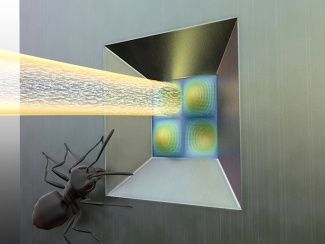Researchers in the Regal group have gotten so good at using laser light to track the exact position of a tiny drum that they have been able to observe a limit imposed by the laws of quantum mechanics. In a recent experiment, research associate Tom Purdy, graduate student Robert Peterson, and Fellow Cindy Regal were able to measure the motion of the drum by sending light back and forth through it many times. During the measurement, however, 100 million photons from the laser beam struck the drum at random and made it vibrate. This extra vibration obscured the motion of the drum at exactly the level of precision predicted by the laws of quantum mechanics.
This extra vibration is interesting because its detection indicated that the experimenters had reached an important limit on successive measurements imposed by a particular law of quantum mechanics known as the Heisenberg Uncertainty Principle. The group’s detection of the Heisenberg Uncertainty Principle in action in the drum was recently reported in the February 15, 2013, issue of Science.
The Heisenberg Uncertainty Principle dictates that the closer someone comes to measuring the exact position of an object, the less that can be known about how fast the object is moving. In other words, this law recognizes that it is not possible to both precisely measure the position of an object and how fast it is moving at the same instant. Of course, how fast something is moving has a whole lot to do with its exact position in the future. This paradox results in a conundrum for the experimental physicist: Do we make the best position measurement now or obscure the motion later?
Physicists pursuing precision measurements, including those working on the upcoming advanced Laser Interferometer Gravitational-Wave Observatory (LIGO), have been discussing what to do about this conundrum for a long time. Regal says the easiest way to get the best precision is to give up precise knowledge of an initial position to balance the combined uncertainty in position and velocity. However, there are fancy measurement techniques that, in theory, would allow the researchers to work around, or avoid, the limits to successive measurements imposed by the Heisenberg Uncertainty Principle.
The challenge of working around quantum limits is irresistible for several physicists at JILA. It’s especially enticing for Regal, whose experimental system runs up against quantum mechanics even though it is relatively large. The square drum at the heart of the recent experiment measures about 0.5 mm on a side. It is large enough to be visible to the naked eye and about half the length of the world’s smallest ant.
Two aspects of the recent experiment made it possible to observe very small vibrations due to quantum mechanical effects. First, the experiment was done at the very low temperature of 5 K (-451 °F). This temperature reduced the amount of vibration caused by heating of the experiment by the surrounding environment. Second, the researchers use special drums that lose vibrational energy to the environment very slowly.
Thus, when the researchers measured vibrations during the experiment, they were able to determine that quantum mechanical fluctuations of light were causing about half of them. Because the group now knows what these fluctuations look like in an experiment, the researchers’ next big step is an experimental investigation of creative ways to work around the Heisenberg Uncertainty Principle in continuous position measurements. Stay tuned. — Julie Phillips




